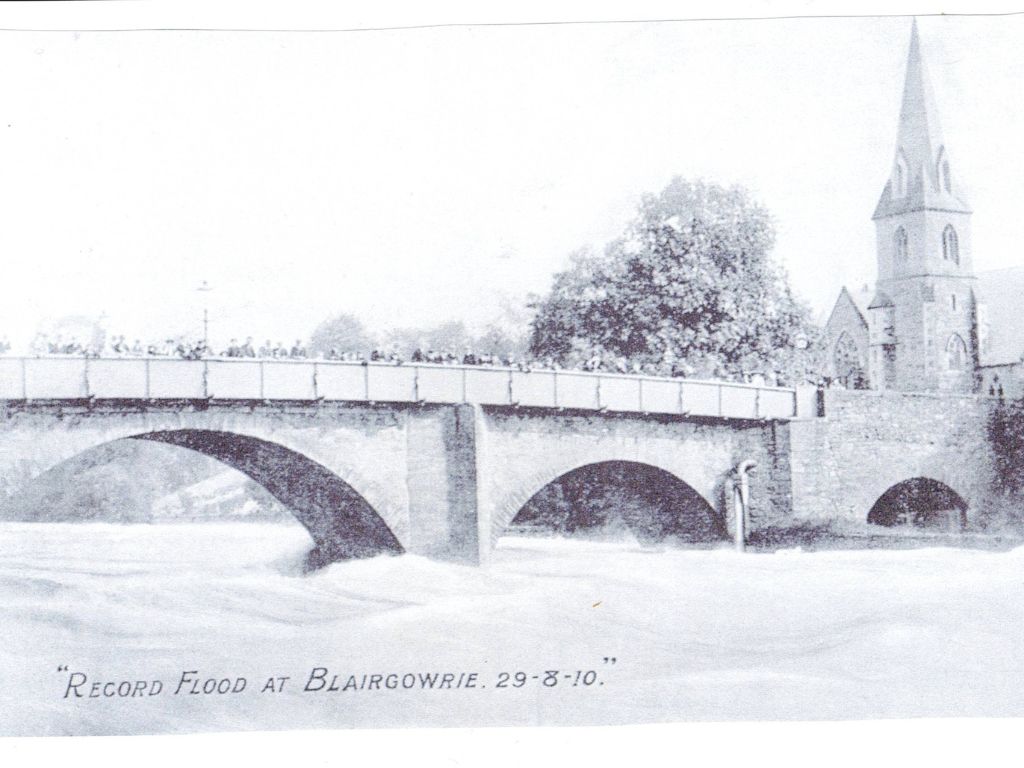The River Ericht and its Bridges

Article Details
- Date:
- c10,000 years ago - Ericht & Bridges
Categories
The River Ericht and its Bridges
The story of the Bridges over the River Ericht
“I beg your pardon,” said the Mole, pulling himself together with an effort.”You must think me very rude; but all this is so new to me. So-this – is – a – River!”
“The River,” corrected the Rat. – ‘The Wind in the Willows’ by Kenneth Grahame.
For the residents of Blairgowrie and Rattray there can be no doubt which river is The River. It is the River Ericht which links the two burghs of Blairgowrie and Rattray. It is to the River Ericht that Blairgowrie and Rattray owes its transformation into the town it is today, the largest town in Perth and Kinross, Scotland. The River Ericht was born at the time the ice melted around 10,000 years ago. It is formed just below Bridge of Cally, where the Blackwater and Ardle rivers join together, and then flows south-eastwards for around 10 miles before meeting the River Isla at Coupar Grange,eventually joining the River Tay, Britain’s largest river, near Meikleour at Islamouth, and flowing to the North Sea.
BEAUTEOUS
The name Ericht is said to come from the Scots Gaelic ‘eireachdas’ meaning beauteous, which so aptly describes both the river and the landscape through which it flows. There can be few other rivers that provide a more pleasant walk along its banks in any season of the year with so much natural and historical interest. In addition, there are attractive sculptures to admire.

IREFUL Of the River Ericht the 1791 – 1799 Statistical Account records: ‘from its rapidity, (it) has acquired the appellation of the Ireful Ericht - - - its channel is very rocky and uneven and it often varies in its depth and breadth. The banks in many places are so low, that it frequently overflows them, and does considerable damage especially at harvest. In other parts they rise to a great height, are very rugged, and often covered with wood’.
CRAIGHALL GORGE
Over the centuries the River Ericht has carved its path down through the Old Red Sandstone rocks to form the Craighall Gorge, the second deepest (after Corrieshalloch) in Scotland. On account of a number of rare plants and lichens and the mixed ash woodland, the Craighall Gorge is designated as a Site of Special Scientific Interest (SSSI).
THE FALLS OF ERICHT AND CARGILL’S LEAP
About half a mile (0.8km) from the centre of Blairgowrie the river rushes down a gorge, forming a cascade known as the Falls of Ericht a.k.a. The Keith. It was here that Donald Cargill leapt across the river to escape capture by government troops. See the article about Donald Cargill here.
THE DOOKIN HOLE
In the Scots language ‘dookin’ means bathing or swimming. The dookin hole, just above the Brig o’ Blair, is where many young people would swim. It is also a pool favoured by anglers. See a painting by William Geddes (1841 – 1884) https://www.christies.com/en/lot/lot-4052020
THE INDUSTRIAL POWERHOUSE THAT WAS THE RIVER ERICHT
The River Ericht once powered a series of 14 spinning mills. See The Mills article here
CROSSING THE RIVER ERICHT
Before the bridge over the Ericht was built, all traffic crossed by a ford located where the weir is now. Pedestrians were taken across in a small coble or boat. The Coble Pule was where the boat crossed the river, and it is from the boat crossing that Boat Brae, the steep road leading up to Rattray, takes its name. A memorial to the wife of the last boatman of Blair and their 4 children, which used to be in Rattray Churchyard, is now inside the Church to prevent further weathering. The Memorial Inscription reads: Heir lays Marjory Morson & 4 of her children. She lived in Maraig with Robert Bennet at the Boat of Blair 14 years and died 17 March 1710 aged 45.
A full description and image of the memorial may be seen at
https://doi.org/10.9750/PSAS.043.206.240

EARLY BRIDGE
An article in the Dundee Courier dated 20 February 1868 refers to an early bridge over the Ericht started in 1635 and completed in 1640 ‘near Moncur’s Flax Mill (Westfield Mill) or betwixt it and Ashbank Mill. When that bridge gave way we have no account.’
THE BRIG O’ BLAIR
Built in 1777, this three arched bridge carries the main road which links Blairgowrie and Rattray.
1871/72 Widening
Of the need to improve the Brig o’ Blair, the Blairgowrie Advertiser dated 25 February 1871 reported: ‘The extreme narrowness of the structure which at the present moment spans the Ericht and forms the only direct route of communication between Rattray and Blairgowrie, has often been a matter of regretful comment, expressed in our columns and elsewhere. Strangers have wondered why a thriving town like ours could put up with such a really insufficient bridge – so miserably constructed as often to jeopardise the lives of the lieges.’ ‘When it so happens that two vehicles have to pass each other on the bridge the whole available space is occupied, and the unfortunate pedestrian is subjected to the utmost peril.’ The work of widening the bridge started in September 1871 and was completed by June 1872.

1954/55 Widening
Extensive alterations to the bridge were carried out in 1954/55. The stone piers were replaced by bearer walls on which concrete beams were laid to carry the widened bridge. The Blairgowrie Advertiser on 27 May 1955 reported: ‘The widening of Blairgowrie Bridge, which was started early August last year, is completed, except for a few finishing touches. As mentioned last week, two-way traffic was resumed last Thursday afternoon. Traffic had been restricted to one-way, regulated by red and green automatic lights, while the work was in progress. The new bridge is ten feet wider than the former structure. The carriageway is 22 feet wide and the pavement on each side has a width of 6 feet 4 inches. The overall length of the bridge is 205 feet. The carriageway of the old bridge was only 16 feet wide and each of the pavements was 4 feet 4 inches in width. Local people are impressed by the appearance of the bridge. Vehicle drivers will appreciate the extra width of the carriageway, and pedestrians, unquestionably, will be grateful for the wider pavements.’

Floods
Over the years, floods have threatened the structure of the bridge. In the October 1847 flood, the arch on the Blairgowrie side was damaged, but was quickly repaired. This 1910 photograph by D. G. Monair published in the Perthshire Advertiser shows that when the river is in flood it can rise to a few feet of the bridge.

KITTY SWANSON’S BRIDGE
Built originally to replace a ferry crossing over the River Ericht, the bridge we see today is the third built on this site. For more about Kitty Swanson’s Bridge click here.
HAUGH OF DRIMMIE BRIDGE
This suspension bridge, around 4.8 km north of the town, dates from around 1830 and is listed Category A. Built to serve Glenericht Lodge it is mentioned in the 1837 New Statistical Account of Scotland: “The only other object pertaining to this parish, which I shall mention as a matter of curiosity, is an iron bridge, which Colonel Chalmers of Glenericht, has thrown across the river, a little below his house. The bridge is supported by a stone pillar at each end, from which a direct span, not an arch, stretches across the whole breadth of the river. The bridge is of such wideness as to admit a passage for a carriage, with a foot tract on the side for travellers, the bottom or floor of both of which is covered with gravel to prevent alarm to man or beast. By this bridge, the Colonel has easy and elegant access to his property on both sides of the river, and also to the great road which runs from Braemar to Perth.” https://canmore.org.uk/site/29160
OAKBANK FOOTBRIDGE
This 52 metre footbridge linking Oakbank Mill to Keathbank was built by the Royal Engineers in 1989 under the Military Aid to the Civil Community programme.
CRAIGHALL BRIDGE Just a mile or so north of Blairgowrie the A93 road winds its way through the Craighall Gorge and crosses the River Ericht. The first Craighall Bridge was erected in 1762 and replaced in 1937 to cope with the increase in traffic. A serious landslip in 1985 led to part of the road collapsing into the Craighall Gorge. As a temporary measure in order to maintain traffic flow a Bailey Bridge was quickly erected. It was single track and was controlled by traffic lights. Twenty- three years later, in September 2008, the new re-aligned 2.4 km section of the A93, costing £5 million plus, was completed.
For information about and images of a bridge over the River Ericht built around 1886 visit. https://www.harperbridges.co.uk/craighall
